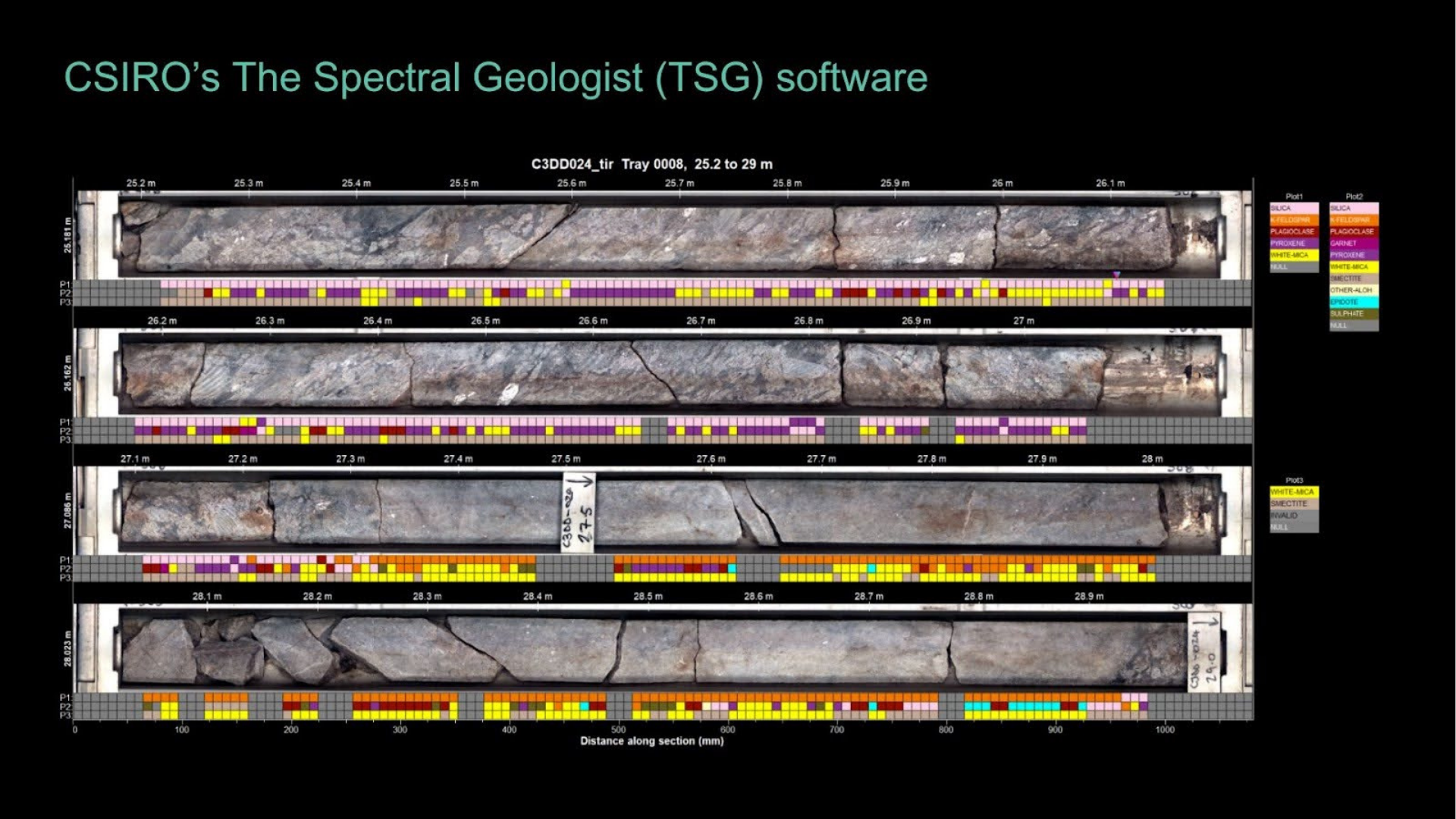National Virtual Core Library (NVCL)
Building Australia’s mineralogy database
The newly installed Hylogger 4 at the Geological Survey of South Australia’s Hylogger facility. Image: Geological Survey of South Australia (GSSA) AuScope edited
A geologist's library looks very different from one we might imagine filled with books. In Australia, geologists have access to the National Virtual Core Library (NVCL), which is full of data about minerals and rocks from around the country. But the NVCL is more than data. It also enables and provides access to globally unique research infrastructure and expertise in drill core analysis, as well as tools and training to support researchers and industry.
Overview
The NVCL is the world's largest online drill core mineralogical database, with over 1.6 million meters of drill core data freely accessible to users anywhere in the world. The NVCL datasets are available via the AuScope Discovery Portal.
Check out our latest video, celebrating the NVCL journey to date. Video: Mintox Media, 2021
The backbone of the NVCL infrastructure comprises the CSIRO-developed HyLogger-3 hyperspectral core-scanning system and Corescans new Hylogger-4 system. Users can find HyLogger systems in six State and Territory geological surveys together with experts who operate instruments, perform quality control on data, and upload it to the AuScope Discovery Portal for open access.
NVCL facilities are located in six State and Territory geological surveys around the country. Image: AuScope
The Hylogger systems provide a continuous line scan of reflectance spectroscopy data with automated mineralogical interpretation, as well as high-resolution core photography that can be visualised and analysed in The Spectral Geologist (TSG) software, the AuScope Discovery Portal, the NVCL Explorer web app, and with the NVCL-kit python package.
Tray screen in CSIRO’s The Spectral Geologist (TSG) software showing drill core from the Greenbushes Li-pegmatite deposit and the transition from Li-rich pyroxene (spodumene) to Li-poor K-feldspar dominated mineralogy (as shown by the automated hyperspectral mineralogy outputs (purple - pyroxene, orange- K-Feldspar)). Image: TSG.
What We’re Working On
Improving Data Quality, Integrity, and Interpretation
The NVCL team works in collaboration with the NVCL nodes and researchers to ensure data quality and integrity, and provide QA/QC and validation of NVCL datasets. This includes continued enhancement of TSG’s mineral spectral reference libraries (SRL) (which is used for automated mineral interpretation) and developing best practice workflows for generating new NVCL drill core datasets. Questions? Please ask Dr Bobby Pejcic (SRL’s) and Dr Cam Adams (petrophysics and geochemistry) at CSIRO – Mineral Resources.
Accessing New Geological Systems
The NVCL supports greater nation-wide representation of core data collection. This is achieved through access to portable tools for analyzing drill cores, and through moving regional and remotely stored cores to research infrastructure nodes at the geological surveys for HyLogging. To date we have helped access 192,000 meters of drill core, adding new and exciting datasets to our NVCL database. Questions? Please ask Dr Ian Lau at CSIRO – Mineral Resources.
Providing FAIR Data
The NVCL is committed to providing findable, accessible, interoperable, and reusable (FAIR) data. To do so, we are continually improving the NVCL database in the AuScope Discovery Portal and developing new tools for visualizing data outputs. The NVCL Data Analytics Layer available on AuScope’s Discovery Portal allows researchers to search for mineral groups of interest from more than 5900 drill core data sets. We also undertake activities to improve data access, interpretation and integration methods. Questions? Please ask Peter Warren at CSIRO – Mineral Resources.
Outreach and Training
The NVCL team offers workshops several times a year to help provide students, researchers and industry geologists with the background knowledge and tools to make the most out of the NVCL datasets. We also organize a yearly NVCL technical meeting which brings together the entire NVCL community for discussions and knowledge transfer on the advances in data collection, interpretation and analysis. Questions? Please ask Dr Jessica Stromberg at CSIRO – Mineral Resources.
News
Pathways to Impact
Over the last twelve years, the NVCL has:
Created the world’s largest publicly available drill core database, with over 1.6 million meters of core scanned to date (with more being scanned every week!)
Enabled new research outputs: more than 75 thesis, 50 peer-reviewed journal publications, 150 publicly available reports, and 200 conference presentations to date have used NVCL datasets. Check out our list of key journal publications.
Provided over 500 industry geologists and students with the training and knowledge they need to access, and utilise the NVCL datasets
Facilitated the uptake of the HyLogging systems and HyLogger datasets by six of the Australian State and Territory Geological Surveys, Australian Researchers, and the Resources Sector. HyLogger datasets have been taken up as a standard dataset in the MinEx CRC National Drilling Initiative.
QUICK LINKS
Access geolocated mineralogy and image data in the AuScope Discovery Portal, or access our training and/or resources:
PROGRAM LEADER
Shane Mule
CSIRO – Mineral Resources
ACTIVITY LEADERS
Dr Carsten Laukamp, Dr Bobby Pejcic, Dr Ian Lau, Peter Warren
and Dr Jessica Stromberg,
CSIRO – Mineral Resources
SURVEY LEADERS
Kyle Hughes, GSNSW (NSW)
Tania Dhu, DPIRS (NT)
Suraj Gopalakrishnan, DNMRE (QLD)
Alicia Caruso, GSSA (SA)
Verity Kameniar-Sandery, MRT (TAS)
Lena Hancock, GSWA (WA)
Shannon Brown, DEECA (VIC)
PROGRAM DURATION
Operating since 2006
NEWS & RESOURCES
NVCL LinkedIn (News, Events)
NVCL YouTube (Training)
The Spectral Geologist (Software)
NVCL Published Datasets (Training)
NVCL Published Reports (Training)
IN THE MEDIA



















